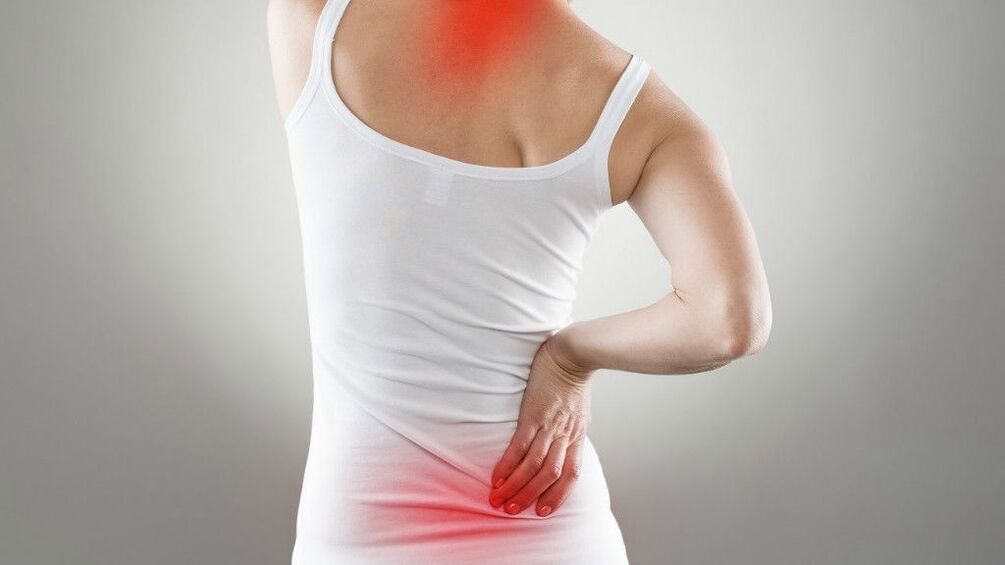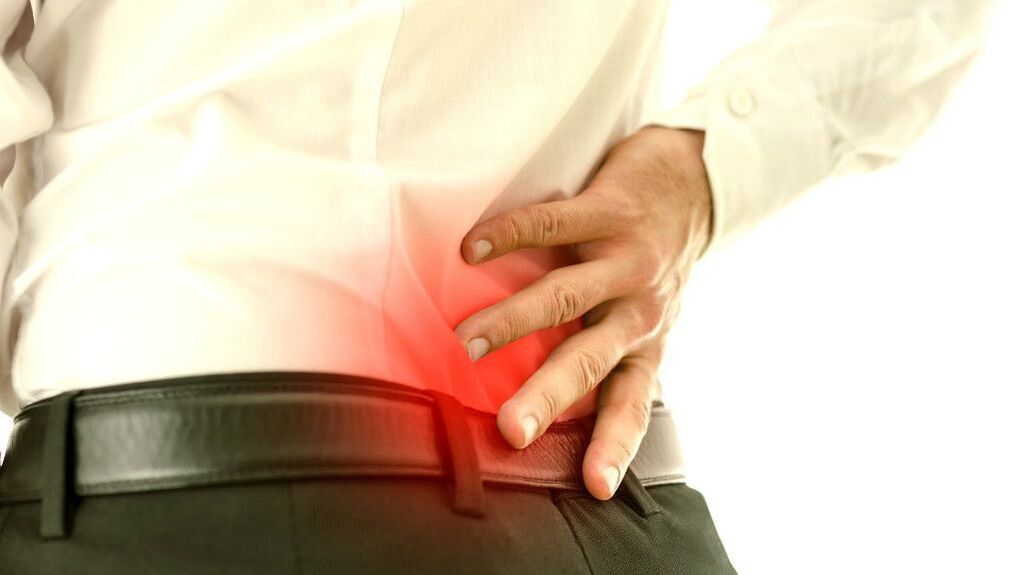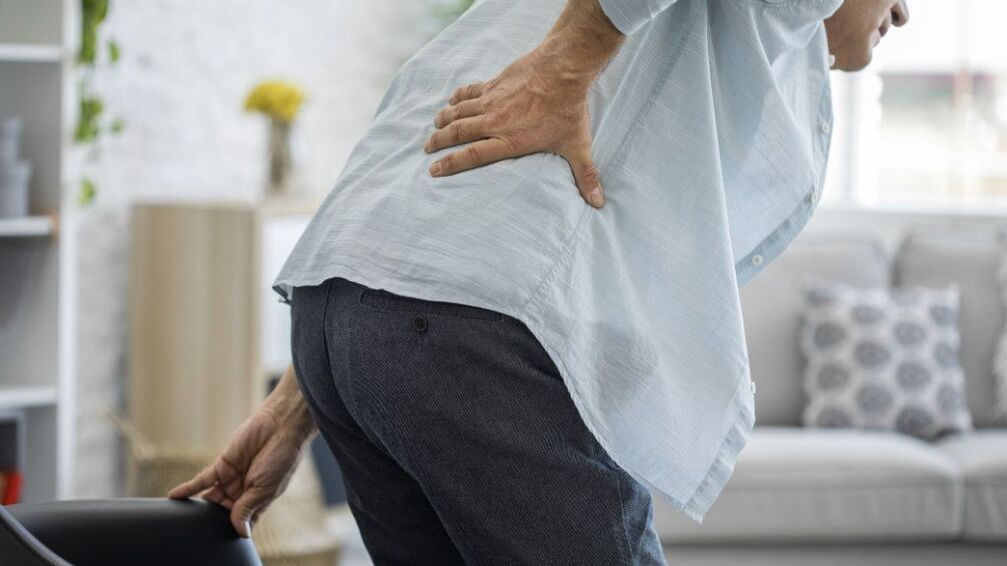Pain, lumbago, constant heaviness, are you familiar with those sensations in the back?
Harmless pulling pain is often a sign of a dangerous disease. In the article we will analyze all the causes of the disease.

Causes
1. Diseases of the spine and pelvic bones.
- Osteochondrosis (damage to the intervertebral discs (protrusion, herniated disc);
- Spondylitis (an inflammatory disease of the spine);
- Spondyloarthrosis (osteoarthritis of the intervertebral joints);
- Spondylosis (bone growth);
- Spondyloarthritis (inflammation of the intervertebral joints).
- Myositis (inflammation of the muscles);
- Osteoprosis (decreased bone density) with compression fractures of the vertebrae and other bone structures;
- Injury to the spine and pelvic bones (fractures, cracks);
- Sacroiliitis (inflammation of the sacroiliac joints);
- Tumors of bone structures and soft tissues.
2. Pain reflected in the lumbar spine,associated with diseases of the abdominal and pelvic organs (inflammatory diseases and tumors), this pain is often accompanied by abdominal pain.
The nature of painIt can be different:
- Acute is pain that occurs quickly, suddenly;
- Chronic - pain for more than 2 months, occurs with the progression of diseases of the spine;
- With inflammatory pathologies of the genitourinary system, abdominal organs (with chronic gastritis, pancreatitis, cholecystitis, enterocolitis).
Pain intensity
From discomfort to severe pain.
In the case of acute and intense abdominal pain radiating to the lumbar spine, it is always necessary to exclude surgical pathology that requires urgent surgical intervention (gastrointestinal bleeding, appendicitis, peritonitis, etc. ).
Intense pain in the lumbar spine.
It can be reflex (muscle spasm caused by irritation of receptors in the paravertebral muscles). It hurts the person to cough, sneeze, all movements are accompanied by pain. When the nerve root is compressed (bulging disc, herniated disc), the pain spreads to the lower extremities, often on one side.
Myofascial syndrome
It is caused by irritation of pain receptors in the muscles and fascia. There is the formation of triggers (pain nodules) in the muscles, the pain syndrome is chronic, often recurrent.
Any trauma to soft tissues or bone structures is also accompanied by severe pain.
When to see a doctor: Any case of pain in the lumbar spine requires a visit to a doctor to help diagnose the cause of the pain and take action.
Pain in men, women
With diseases of the reproductive system, the pain syndrome differs in men and women.
For men with pathology of the prostate, a sharp, painful pain is characteristic, often accompanied by a violation of urination. In women, the symptom is often sharp and pronounced. With ovarian stroke or ectopic pregnancy, the pain is excruciating. Usually the syndrome is more severe on the affected side.
With endometriosis, uterine myoma: pain sensations, pulling If the pain is associated with a pathology of the spine, the intensity of the pain does not depend on gender. It is noted that men go to the doctor later.
Diagnostics
Examination by specialists
- vertebroneurologist;
- gastroenterologist;
- neurosurgeon;
- surgeon;
- gynecologist;
- urologist;
- rheumatologist;
- oncologist.
Laboratory methods
- general blood test (to exclude the inflammatory process, the level of leukocytes, ESR), exclusion of anemia (hemoglobin level);
- general urinalysis: exclusion of the inflammatory process in the bladder, kidneys (bacteria, leukocytes, erythrocytes);
- stool analysis for occult blood;
- Blood chemistry: rheumatological tests to rule out systemic inflammation (CRP, RF, uric acid), assessment of liver function (alt ast bilirubin), assessment of kidney function (creatinine urea), pancreatic function (amylase), etc.
Instrumental research methods
- X-ray of the lumbar spine and pelvic bones, plain X-ray of the abdominal cavity (excluding intestinal obstruction);
- Ultrasound of the abdominal and pelvic organs;
- FGDS;
- colonoscopy;
- Magnetic resonance imaging (CT) of the lumbar spine, MRI (CT) of the lumbar area with contrast;
- Magnetic resonance imaging (CT) of the abdominal cavity and small pelvis, MRI (CT) of the abdominal cavity and small pelvis with contrast.
Treatment
When a tumor is detected, depending on the location and nature of the tumor, treatment, surgical or other tactics are determined (observation and treatment in a neurosurgical, surgical hospital, oncology dispensary).
Drug treatment
Diseases of the spine (most often in the framework of osteochondrosis):
- NSAIDs;
- muscle relaxants;
- opioid pain relievers;
- diuretic drugs;
- vascular medications;
- antibacterial drugs;
- medical and medical blockade with novocaine, lidocaine and diprospan.
Non-pharmacological methods
They are used mainly in the treatment of diseases of the spine:
- physiotherapy (magnetic laser, magnetotherapy, CMT with novocaine, etc. );
- acupuncture;
- lumbar spine hardware traction;
- manual therapy;
- massage;
- balneotherapy (applications of mud, ozokerite);
- Exercise therapy.


Prevention of diseases of the spine (in the framework of osteochondrosis) all of the above methods (except physiotherapy).
Prevention of diseases of the gastrointestinal tract: diet, diet, work and rest.
If you have low back pain, go to the clinic.
The hospital has all the specialists and all the diagnostic methods presented in this article. There are also inpatient departments: a gastroenterology department and a vertebrological center in the city. All treatment methods are used except surgery. It can be monitored, examined and treated on an outpatient basis, that is, outside the hospital.













































